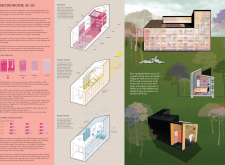5 key facts about this project
The Microhome 4C-20 is a thoughtful response to the changing needs of modern living. Situated in a context where people often work, learn, and relax at home, this compact structure fulfills multiple functions. The design integrates flexibility and sustainability, making it suitable for a variety of lifestyles. The project focuses on a modular approach that allows for adjustments based on the residents' needs, encapsulating the current trend toward efficient, self-sufficient homes.
Modular Structure
The Microhome is made up of four distinct modules: CORE, COMPANION, COMFORT, and COVER. Each plays a specific role to ensure the overall functionality of the dwelling. The CORE module contains essential mechanical and plumbing systems. Its raised floor not only provides a place for the kitchen but also includes bathroom facilities and storage options. Above this level, there is space for sleeping and a dedicated work nook, accessed by a custom ladder that optimizes vertical space.
Sustainable Living Features
The COMPANION module adds to the home’s self-sufficiency with systems designed to collect rainwater and harness solar energy. This module is critical for managing essential utilities, allowing for a living environment that meets basic needs without relying on outside resources. In combination with the CORE module, it establishes a comfortable and efficient home that emphasizes sustainability.
Adaptability and Outdoor Integration
The COMFORT module expands the overall footprint of the Microhome, offering more areas that can change based on how residents use the space. This adaptability allows for a variety of activities, catering to the dynamic requirements of everyday life. The addition of the COVER module introduces an outdoor terrace and canopy, facilitating a connection to the surrounding environment and providing a pleasant outdoor living area.
Innovative Design Elements
One notable design feature is the greenhouse garden wall. It captures sunlight effectively, promoting indoor plant growth while improving air quality. This wall not only enhances the aesthetic qualities of the home but also serves a practical purpose in food production. Passive heating and cooling strategies are employed, utilizing the greenhouse wall’s ability to store heat during the day and release it at night, maintaining comfort without heavy reliance on mechanical systems. The incorporation of rainwater harvesting and greywater management completes the approach to resource efficiency, making the Microhome 4C-20 a relevant example for future residential design.



















































